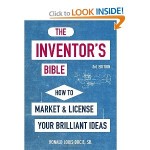 Title: The Inventor’s Bible: How to Market and License Your Brilliant Ideas
Title: The Inventor’s Bible: How to Market and License Your Brilliant Ideas
Author: Ronald Louis Docie Sr.
Cost: $15.99 At Amazon
Book Review
Clocking in at 376 pages, substantially longer than many similar books, this “Inventor’s Bible” begins with chapters on how to commercialize your general concept into a marketable product, formulating a strategy for obtaining patent protection, doing market and industry research and test marketing to fine tune a product concept, and how to go about the licensing process, including the important role that the use of disclosure agreements, properly drafted, can play in being able to present your invention or idea to companies without having it be stolen. Each chapter ends with a case study, making the general concepts clear in a living way.
The Inventor’s Bible also discusses an often neglected topic—the fact that ultimately, you often can no longer do it alone in today’s market. A chapter entitled “Victory through Teamwork” contains a frank discussion of when it is essential to use professional help in obtaining patent protection, effectively communicating your invention, and responding proactively to possible patent infringement. It also examines how to go about the search to find and hire the best competent professionals to be on your “team.” An appendix contains a number of useful charts, an overview of the patent process, criteria to evaluate your invention, and a boilerplate disclosure agreement that can easily be modified and used.
A section towards the end labeled resources is by itself worth the relatively modest price of this substantial book, covering essential information on government contracts and programs, conducting patent searches, other valuable publications for inventors, information about trade shows, and resources for small businesses generally.
The Inventor’s Bible comes in both paperback and ebook editions. A terrific 74-page workbook presented at the very end summarizes in many ways the steps outlined in more detail throughout the text and guides the user step by step through the process of transforming your invention or concept into a viable and marketable product. There is very useful contact information for both manufacturers and distributors whose participation can mean all the difference between a runaway good seller and a product that, despite any inherent great potential just sits on the shelf unnoticed.
Make no mistake about it—this is a book for the inventor who is ready to get down and dirty and get serious about making money with their idea. It is not for the idly curious or the dilettante unwilling to put in some serious effort and apply some serious thought. For those willing to put in the time and effort, it is likely that the rewards will come, provided of course, that the initial invention or concept was worthy of being marketed.
The Inventor’s Bible could have benefited from a more det ailed discussion of publicity, advertising, and public relations, those essential elements to creating a buzz about a product and making a new product something that the consumer has to have and believes he really needs, even if there was no real “need” for it before.
